Media | Articles
Style, Technology, and Speed: Mid-Size Coupes of the 1990s Had It All
The buzz around the recently confirmed sixth-generation Honda Prelude demonstrates that enthusiasts are hurting for a proper coupe. Maybe we’ve only begun to appreciate them now that they’re gone, but it’s easy to forget that the market was once awash with sleek two-doors, as widely adored by those who simply wanted to cruise in style and those who would ditch the interior fixings, fit a loud exhaust, and terrorize wildlife in their local canyons.
We’ve looked at the lower end of the market before, with the CRXs, Storms, and ZX2s that served as the entry point to each manufacturer’s sports car range. This time we’re looking at the next step up, where 2.0-liter engines (and more) were the norm, where tech like four-wheel steering and four-wheel drive began to creep in, and where you could feasibly fit a few more passengers in the back seats.
Audi Coupe
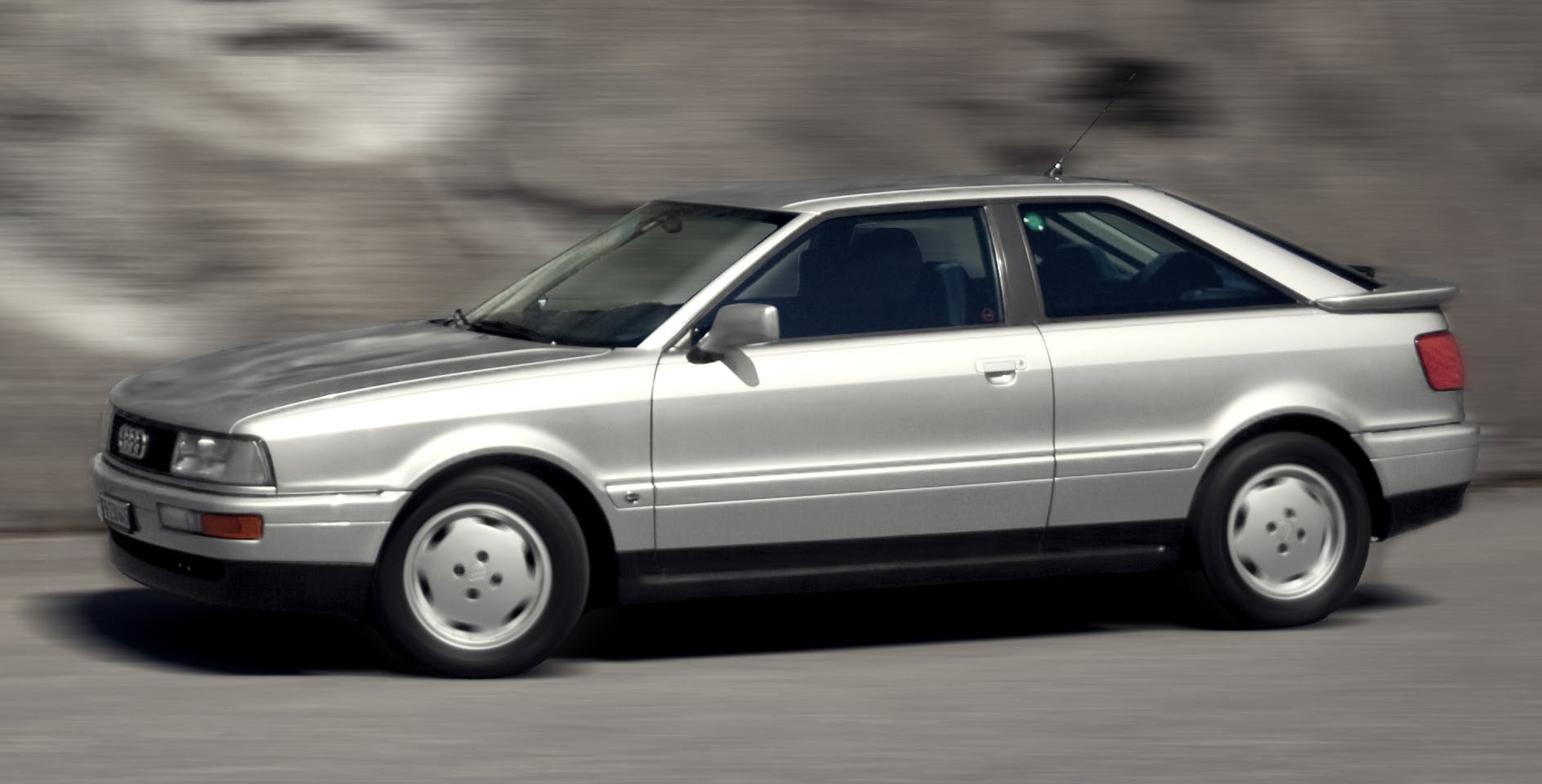
What is it? It was technically a child of the 1980s, as the Audi Coupe arrived in 1988. But it hung around until 1996, leaving a coupe-shaped gap in Audi’s range until the seminal TT arrived in 1998. We’re going with gut feeling here, though, given this was the brand’s figurehead well into the 1990s.
Why was it great? Based on the 80 sedan, the Coupe gets immediate bonus points for offering four-, five-, and six-cylinder engines during its production run, the five-cylinder also getting a turbocharged S2 variant with Quattro all-wheel drive and 217 hp. What the S2 never quite did is top its legendary, rally-homologation predecessor, either for impact or fun factor. All models were safer than they were fun, in fact, and perhaps their placement between the Ur-Quattro and the designer’s favorite TT is why the Coupe is often forgotten today.
BMW 3 Series Coupe (E36)

What is it? Perhaps the best-looking version of arguably the definitive 3 Series shape. More sophisticated than its E30 predecessor, the E36 was one of those cars still winning group tests until it was replaced by the E46 in 1998, and is known, among other things, for being the generation that turned the M3 from a raw homologation special into a capable do-anything performance car.
Marketplace
Buy and sell classics with confidence
Why was it great? All the usual BMW virtues: front-engined, rear-drive, widely available manual gearbox, balanced handling, impeccable body control (at least by 1990s standards), handsome styling, and spectacular motorsport success. In fact, the E36 (in both coupe and sedan form) won 30 titles in the Super Touring era of tin-top racing (twice that of the Audi A4 Quattro), everywhere from Europe to Japan and Australia. Road-going models are just as good to drive, and just as easy to use daily, as they ever were.
Chevrolet Beretta
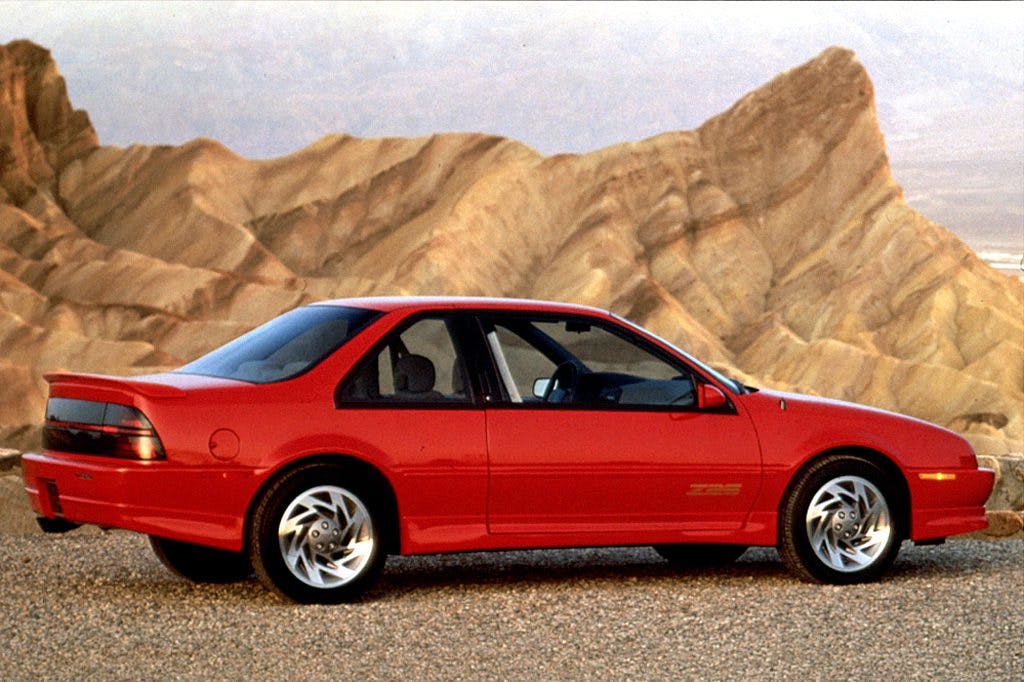
What is it? One of a handful of cars here with its roots in the 1980s, but with rounded-off styling and suitably Radwood color options that allow it to pass as firmly 1990s in our hearts and minds. Unlike some U.S. rivals at the time, this one was all-American, rather than a joint venture with Japanese brands, with engines including the 2.3-liter Quad 4 and the 3.1-liter GM V-6.
Why was it great? The Beretta kicked off the ’90s in style with a Trans-Am series win. In reality, road-going versions were a little too portly (about 2800 pounds) to be great backroad blasters, and its ’80s engineering was readily apparent in its cornering behavior. But great styling and low pricing even for the V-6 meant it was priced closer to coupes from the class below, which made it a no-brainer for some customers, compared to something Japanese with a four-banger for five grand more.
Dodge Daytona

What is it? You probably wanted a Dodge Viper in the early 1990s, but if you couldn’t stretch to one, then you might have looked at the Mitsubishi-based Dodge Stealth. And if your bank manager said no to that one, too, then the Daytona, a G-body hangover from the 1980s, was next on the list, with the option of turbocharged power and styling that didn’t look out of place in the ’90s, thanks to a 1992 facelift.
Why was it great? Although it couldn’t quite match the new wave of Japanese coupes for ability, the Daytona had price on its side: a starting figure of $11,000 was half what you could quite easily spend on a Prelude, and four grand less than a Probe. The 224-hp of the top IROC R/T was healthy for the early ’90s, too.
Dodge Neon ACR
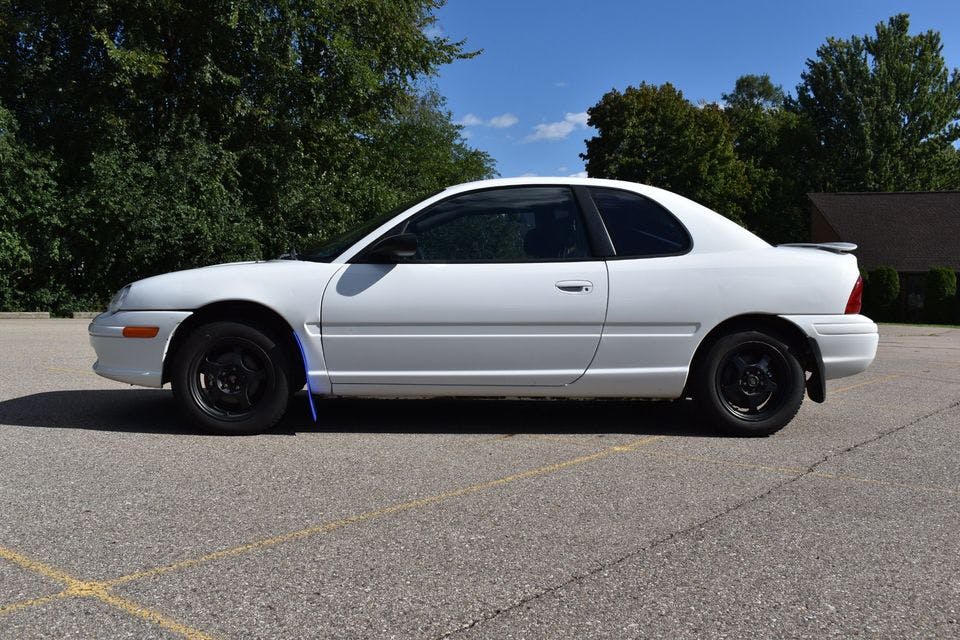
What is it? These days, Porsche would call it a GT3, though the old Clubsport versions of Porsches are probably more appropriate: Think normal road car (in this case, the humble and friendly-looking Plymouth/Dodge Neon) with weight stripped out and a bunch of chassis and running gear modifications (dampers, sway bars, bushings, shorter final drive, quicker steering) to prepare it for racing. Initially, the ACR was sold only to SCCA members. We’ve put it in this list but should point out that you could also get the ACR as a sedan, too.
Why was it great? If you were in the grassroots motorsports scene in the mid 1990s, then the ACR was great because it was a Civic-beater out of the box. Today, it’s great because it’s a snapshot of a thing that companies don’t really do any more—the idea of the stripped-out road racer is basically extinct, outside of the aforementioned Porsches, and even those are still more street than circuit.
Eagle Talon

What is it? The U.S.-badged version (alongside the Plymouth Laser) of the Mitsubishi Eclipse, as part of the Diamond-Star Motors joint venture between Chrysler and Mitsubishi. Not the greatest meeting of minds, perhaps, but other than one or two mechanical maladies that have since come to light (exacerbated by the platform’s popularity for tuning), it was a well-received coupe in its day.
Why was it great? The first-gen car just sneaked in with a 1989 release date, and it had smart looks and fantastic value on its side. Like the Ford Probe below, the Talon was talented enough to see off all-comers (seven other cars, this time) in a 1992 Car and Driver comparo. Basic versions were available but even the turbocharged, 195-hp all-wheel-drive version started at less than $18,000; not bad for a stylish coupe with a 6.5-second 0–60mph time. From 1995-on, the second-gen got curvy and power rose to 210 hp in the AWD TSi.
Ford Probe

What is it? In first-generation form, the car that nearly replaced the Mustang. In second-gen form, launched in 1992, a surprisingly pretty two-door liftback with available Mazda V-6 power that reviewed well—in a 1993 Car and Driver test against the Mitsubishi Eclipse, VW Corrado, Honda Prelude, and mechanically similar Mazda MX-6, the Probe walked away with victory.
Why was it great? Well, in that C/D test, the Ford took honors for its confidence-inspiring handling and revvy V-6 engine, while being more fun than the directly comparable Mazda. Plus, it was a bargain: With a base price of around $15,500, it was about $3500 cheaper than the MX-6 and miles below the $22,500 Prelude Si. Plus, pop-up headlights …
GM EV1

What is it? The odd one out here for as many reasons as you can list, but too interesting to leave off. GM’s first serious attempt at an electric car just happened to take the form of a sporty coupe when it landed in 1996, and while canyon carving and straight-line performance weren’t priorities, it’s probably more historically significant than any other car here.
Why was it great? For showing, at least by 1990s standards, that electric cars needn’t be gawky penalty boxes, weird kit cars, or sketchy conversions of regular gas-powered models. It was designed as an EV from the ground up, and while its range and performance don’t look like much today (142 miles, around eight seconds to 60 mph), it was a serious, well-thought-out car and genuinely usable. After GM turned most of them into cubes in 2003, only a handful remain, and fewer still in working order.
Honda Prelude (4th gen)
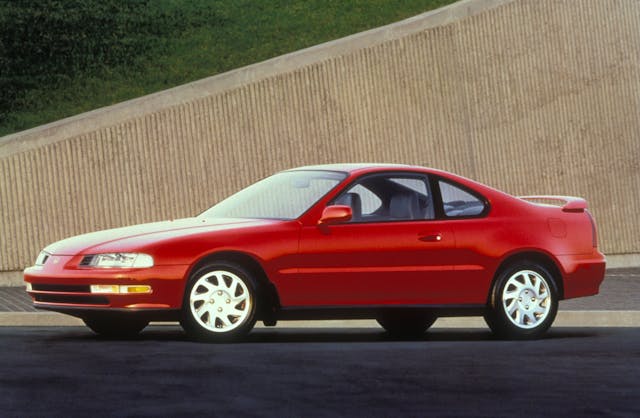
What is it? Honda’s core coupe model line since 1978. Three generations intersected with the 1990s, the third, fourth, and fifth, but it’s the middle of these that feels the most 1990s. The fourth-gen Prelude is actually a bit of an odd one out in the lineage (until the upcoming hybrid, anyway), ditching most of the styling cues of the three models that preceded it, but grown-up performance and high technology were still key features.
Why was it great? A mix of Honda’s howling powertrains and sophisticated chassis tech made this the coupe to beat during the 1990s, at least in the U.S. market. Top of the engine food chain was the 187-hp 2.2-liter H22A, which also came with the Prelude’s four-wheel steering party trick, this time electronically controlled in contrast to its mechanical predecessor. Fluorescent light tube gauges gave the cockpit a Starship Enterprise vibe.
Hyundai Tiburon
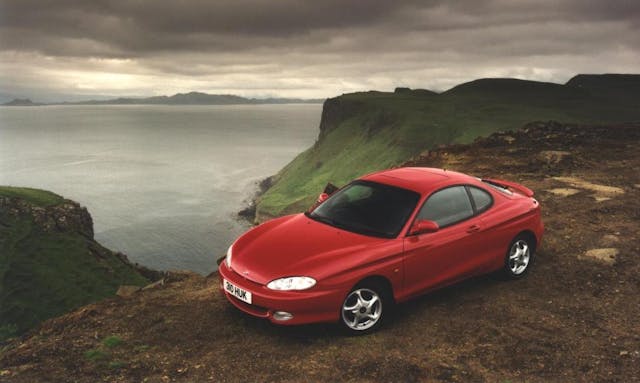
What is it? People wouldn’t blink at a sporty Hyundai today, but 1996’s Tiburon seemingly came out of the blue. It replaced the bland and curiously named Scoupe with a more sophisticated, Coke-bottle look tying it to the contemporary Elantra, and it had 1.8- and 2.0-liter fours to pull its modest (around 2500 pounds) weight along.
Why was it great? Hyundai still enjoyed a healthy dose of public cynicism in the 1990s, so simply by being better than expected, the Tiburon was fondly received. The Korean company had turned to Porsche to refine the car’s chassis, and while it wasn’t exactly a front-drive Boxster, it handled neatly. Likewise, the engines could get a bit raucous but performed well enough, and a base price of around $14K made it accessible too.
Mazda MX-6

What is it? Mazda’s mid-size coupe, slotting in between the smaller MX-3 and the larger and much more serious RX-7. It used mainly 626 mechanicals, which meant, depending on the market, a choice of a 2.0-liter four-cylinder, or 2.0- and 2.5-liter V-6s. Pretty styling fit right into the attractive 1990s Mazda range.
Why was it great? The MX-6 took more of a softly-softly approach to the ’90s coupe formula than the Prelude or Celica did. The V-6 engine majored on refinement and tractability—it could happily, if not especially briskly, pull from idle in top gear without protesting—but the handling was just involving and agile enough (four-wheel steering was an option in some markets) to hold its own.
Mercury Cougar

What is it? Depending on your market, the eighth-generation Mercury Cougar was a direct replacement for the Ford Probe. In Europe, it wore Ford badges and arrived in 1998 to try and fight with local coupes like the Alfa Romeo GTV and Fiat Coupe. In the U.S., the Mercury was the spiritual successor to the Capri of the 1980s—ironically, meaning a front-drive coupe from Ford did indeed replace a Mustang. Just not in the format we expected.
Why was it great? This might be one where “great” is overstating things a little, though it certainly wasn’t bad. The Cougar was based on the Ford CDW27 platform, better known for the Contour (or in Europe, the highly praised Mondeo). That meant it handled well, and got a choice of 2.0-liter Zetec four or 2.5-liter Duratec V-6 engines, plus the all-important stick shift. Early sales were strong, but tailed off rapidly, and the Cougar disappeared in 2002.
Nissan 240SX (S14)

What is it? Today you’re lucky to find an S14-generation Nissan 240SX that hasn’t spent the last 15 years ricocheting between concrete walls at your local drift track, but in period it was a mainstay of the coupe sector and one of only a handful to resist the push toward front-wheel drive.
Why was it great? Rear-drive handling, mostly. Its styling, simple and well-proportioned, looks better today than it did 30-odd years ago, when it perhaps seemed a little bland alongside Preludes and Celicas. The long-stroke KA24DE engine was a carryover from its pop-up headlight predecessor and not the smoothest of motors, but with upwards of 155 hp it was (and still is) enough to poke the tail out on a damp road. Cars from 1996-on look a little sharper.
Toyota Celica (T200)

What is it? Another Japanese coupe with a long heritage, this time stretching back to 1970. And another where three generations spanned the 1990s—the T180 with its pop-up headlights, the four-headlight T200, and just before the decade was out, the lightweight and sharply-styled T230. We’re focusing on the T200 here, which came in notchback and liftback forms, and in GT-Four form, is known as one of the great racing car cheaters, after getting kicked out of the WRC for turbo trickery.
Why was it great? Celica model lines came thick and fast in the 1980s and ’90s, with refinements at every step. There was some Supra in the T200’s stocky lines, while the four-headlight front gave it a characterful face at a time when most manufacturers were still sticking with oblong lights and traditional grilles. Handling is agile and like most Toyotas, it was built to last. A modest 135-hp 2.2-liter 5S-FE engine powered most U.S. Celicas, but the 241-hp, four-wheel-drive GT-Four has been eligible to import for a few years now.


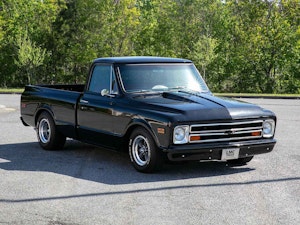






















With the GR86 and BRZ as well as the new Prelude coming back, I am excited that there’s a comeback of affordable coupes in today’s market
Even Toyota is bringing back the Celica and Dodge said there’s still a case for a $30k sports car so who knows maybe coupes can become a thing once again
I’d kill to have my ’99 300M back. No screen, sensible buttons and switches, more than adequate performance, a real, classic instrument cluster and I loved that Autostick. Too bad Ohio salt ate it from the bottom up after 156k.
All disposable toasters.
My brother had both that Probe, and after that, the Cougar pictured; the Probe was much better in every way, and a nice car. The Beretta was a handsome car, and GM styling was particularly clean in that era. I really miss my humble ’96 Plymouth Breeze (think Stratus if you’ve forgotten them) – 2.0L and 5-speed stick, 40MPG and full of the “slow-car-fast” attitude – got over 320,000 trouble-free miles out of it before the electronic engine controls deteriorated.
I bought a brand new 1994 Chevy Beretta GT with the 3.1 automatic. I put 80,000 plus miles on that for 8 years in Western NY including winters. The only warranty work on it was an engine oil leak from the rear intake manifold seal. It looked nearly as new when I traded it in for a 2002 Monte Carlo SS. Never see them anymore. It was white with bright red velour interior. It was the perfect size commuter car.
Not a mention of the superbly engineered Lexus SC300/400 which in fact influenced the rounded streamlined appearance of many of the long low coupes (you show the 240sx, almost a direct copy). Same platform they used for the Supra, coveted 2JZ motor in the SC300, and remain gorgeous cars to this day. Still affordable, and some of the SC300’s are available with factory manual trans. Not sure why these continually get overlooked! Very influential, and bulletproof to boot.
Yes! Agreed Steve!
Well, the SC’s may be “mid-sized”, but they sure weren’t mid-priced.
That’s probably why they aren’t on this list.
If I’m not mistaken, the SC400 was the most expensive Japanese car sold in America at the time.
I had one, and still miss it. It developed an unsolveable issue, and I had to let it go.
Agreed they were expensive back then. Very affordable now! I was curious what was “unsolvable” with yours?
There was a lot of fun “sporty” cars back in the day. I owned a ’92 Eagle Talon TSi AWD and a ’97 Eclipse GSX. They were little rockets and their AWD gave them the grip to handle Chicago winters with ease. They used to surprise all sorts of cars back in the day. The Probe was a great car and the Celica was a good car and had a short run of All-Trac models that were a bunch of fun. 240 was a great car for it’s day
I owned a 1993 Mazda MX6 V6 and it continues to be one of my 3 top favorite cars I’ve owned. The V6 was silky smooth and as my son said at the time if he wanted to get moving, “Feel the Force Luke” and it flew. A nice handling and comfortable car that got great gas mileage and for me was wonderful in autocrossing. Much better than my buddy’s Probe. I put 278000miles on it before I bought a larger Mazda6. I still have documentation for upgrading the engine in normally aspirated form to near 450 hp. These cars were successful racers in IMSA and SCCA series.
I can’t remember the last time I saw a MX6 on the road.
How are sales of the latest Nissan Z?
I agree with most of these but would like to add the Nissan Sentra SE-R. Peppy with a 5 speed (unlike a base model Sentra), sharp looking for sure, great handling and gas mileage and a good amount of creature comforts for a relatively inexpensive car. I had one in college, loved that car. Never let me down.
Mid-size? In what world? Other than deleting the EV-1, and the size misrepresentation, I fully agree.
What size would you consider them to be?
Nice feature. I had forgotten how many good-looking coupes there were in the 1990’s (and mid-to-late 1980’s, too). They didn’t always have a lot of power, but they were sharply styled, mostly good-handling, and produced decent MPG.
On the large size of mid-size, we ordered and bought a Topaz Gold 1998 Grand Prix GTP coupe. With its supercharged 240HP engine (and more importantly, 280 pounds of torque), it was certainly not short of power in that era, and had instant throttle response (unlike most of today’s turbocharged cars). Lots of room for my wife, 2 children, and me, a rather big trunk, good handling, and 30+ MPG on the highway. And man, was it good-looking. It served us for twenty years, until it saved my wife in a high-speed drunk-driver collision (they led that driver off in cuffs). I still miss it, but I don’t think I miss it as much as my wife does.
A co-worker had a 240SX. Being RWD, it was helpless in the winter snow that we often have. He replaced it with a Pathfinder, as he was tired of being unable to get to work when it snowed.